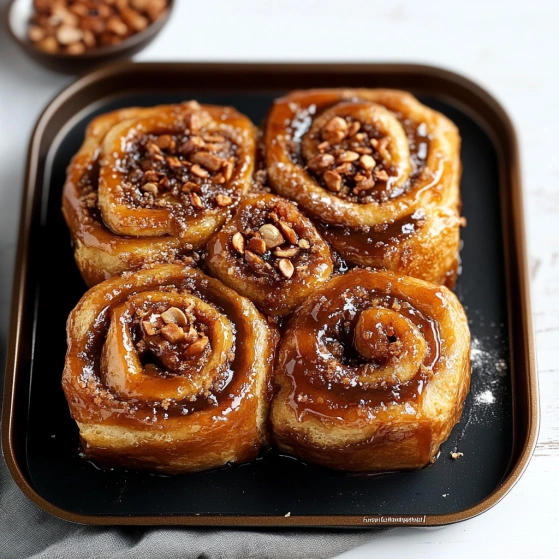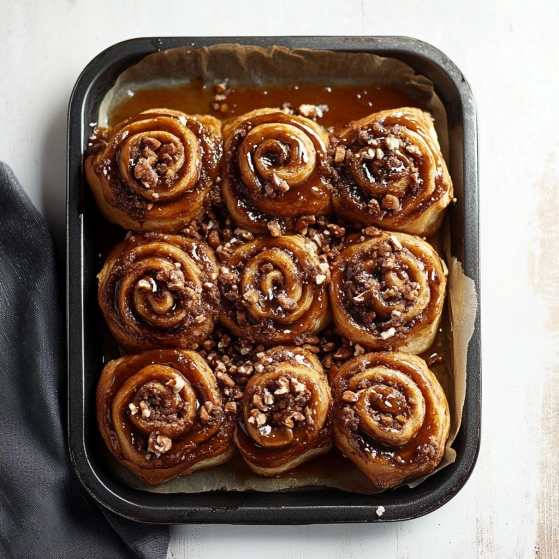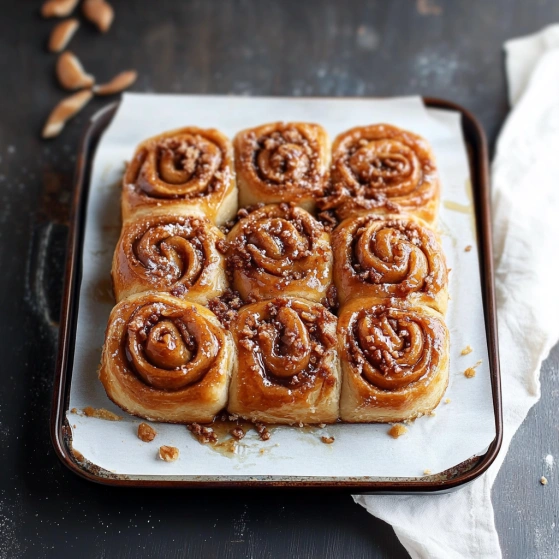 Pin it
Pin it
This homemade sticky bun recipe transforms simple pantry ingredients into a heavenly breakfast treat that fills your kitchen with the irresistible aroma of cinnamon and caramel. The soft, pillowy dough wrapped around a cinnamon sugar filling and topped with gooey caramelized pecans creates an indulgent experience worth every minute of preparation.
I developed this recipe after years of disappointing store bought versions that never quite measured up to my grandmother's holiday morning specialty. The first time my children helped me make these, watching their eyes light up when we flipped the pan to reveal the caramel topping became a memory I treasure.
Ingredients
- Active Dry Yeast: Provides the perfect rise and texture for these buns. Look for fresh packets that haven't expired for best results.
- Buttermilk: Delivers tenderness and a subtle tang that balances the sweetness. Full fat works best.
- Dark Brown Sugar: Creates a rich caramel flavor in the topping. The molasses content gives depth beyond regular brown sugar.
- Light Corn Syrup: Ensures a smooth flowing caramel that coats every curve of the buns. This prevents crystallization.
- Pecans: Add essential crunch and nutty flavor. Toast them lightly before chopping for enhanced flavor.
- Ground Cinnamon: Warms the entire recipe. Choose fresh cinnamon for the most vibrant flavor.
- All Purpose Flour: Provides structure while maintaining tenderness. Measuring accurately prevents tough buns.
Step-by-Step Instructions
- Activate the Yeast:
- Dissolve the active dry yeast in warm water for 5–10 minutes until foamy and fragrant. This step ensures your yeast is alive and ready to work its magic on your dough.
- Create the Dough Base:
- Combine egg, sugar, butter and salt in your stand mixer with the paddle attachment until smooth and well incorporated. Add the activated yeast mixture, buttermilk, and initial portion of flour. The mixture will look somewhat shaggy but combined.
- Develop the Dough:
- Switch to the dough hook and gradually add remaining flour until a soft, slightly tacky dough forms. The dough should pull away from the sides of the bowl but still feel slightly sticky to touch. Resist the urge to add too much flour or your buns will be dense.
- Knead to Perfection:
- Transfer dough to a lightly floured surface and knead for 5–7 minutes. Proper kneading develops gluten for the perfect texture. The dough is ready when it feels smooth and elastic, springing back slightly when poked.
- First Rise:
- Place dough in a greased bowl, turning to coat all sides. Cover with a kitchen towel and let rise in a warm spot for about an hour until doubled in size. The warm oven technique with boiling water creates the perfect environment for rising.
- Prepare Filling and Topping:
- While the dough rises, mix cinnamon and sugar for the filling and prepare the caramel pecan topping. Melting butter, brown sugar, corn syrup, and cinnamon creates a luxurious base that will become the crown of your sticky buns.
- Shape and Fill:
- Roll the risen dough into an 18 x 12 inch rectangle on a lightly floured surface. Brush with melted butter and sprinkle generously with cinnamon sugar, leaving a small border. Roll the dough tightly from the long side, creating a uniform log.
- Cut and Arrange:
- Using a sharp knife or unflavored dental floss, cut the log into 12 equal pieces. Place them cut side down on top of the caramel pecan mixture, allowing space between each roll for expansion during the second rise.
- Second Rise and Bake:
- Cover rolls and let rise until doubled, about one hour. Bake in a preheated 375°F oven for 20–25 minutes until golden brown. The aroma will fill your kitchen as they transform into perfect sticky buns.
- The Grand Finale:
- After cooling briefly for 5–10 minutes, invert the pan onto a serving plate to reveal the glistening caramel pecan topping. This dramatic moment is worth savoring as the caramel drips down the sides of the warm buns.
 Pin it
Pin it
The corn syrup in this recipe is my secret weapon for achieving that perfect sticky texture. My first attempt without it resulted in a crystallized topping that hardened too quickly. Now I never skip this crucial ingredient, especially when making these for holiday morning gatherings where they never last more than an hour.
Overnight Preparation
For make ahead convenience, prepare the rolls through the shaping and cutting stage, then place them in the refrigerator overnight. The slow, cold rise actually develops more flavor in the dough. The next morning, allow the rolls to come to room temperature for about 30 minutes before baking, which is just enough time to preheat your oven and brew a pot of coffee.
Troubleshooting Yeast Dough
Sticky bun success depends largely on proper yeast activation and dough temperature. If your kitchen is cold, your dough will rise slowly. The ideal temperature for yeast development is between 75–85°F. Never use hot water for activating yeast as temperatures above 110°F will kill it. If your dough seems sluggish, create a warm environment by placing it near a sunny window or using the oven technique described in the recipe.
 Pin it
Pin it
Serving Suggestions
These sticky buns shine as the centerpiece of a special breakfast or brunch. Pair them with savory elements like a vegetable frittata or bacon to balance the sweetness. For an extra special touch, serve with cream cheese on the side. While perfect on their own, these buns also complement fresh fruit and hot beverages brilliantly. For an indulgent dessert version, serve warm with a scoop of vanilla ice cream.
Storage and Reheating
Store leftover sticky buns in an airtight container at room temperature for up to two days. For longer storage, refrigerate for up to a week or freeze for up to three months. To reheat, warm individual buns in the microwave for 20–30 seconds or place several in a 300°F oven for 10 minutes until heated through. Add a small pat of butter on top while reheating to refresh the moisture and glossiness of the caramel topping.
Frequently Asked Questions
- → Can I make these sticky buns ahead of time?
Yes! You can prepare the dough the night before and let it rise slowly in the refrigerator overnight. In the morning, allow the dough to come to room temperature for about 30 minutes before rolling, filling, and proceeding with the second rise and baking.
- → Can I substitute the pecans with other nuts?
Absolutely! Walnuts work wonderfully as a substitute for pecans. You could also use almonds, hazelnuts, or even go nut-free by omitting them completely or replacing with dried fruit like raisins.
- → Why did my dough not rise properly?
Several factors affect dough rising: 1) Check that your yeast is fresh and activated properly in warm water, 2) Ensure your kitchen is warm enough (70-75°F is ideal), 3) Give it enough time - sometimes dough needs longer in cooler environments, and 4) Make sure your liquids weren't too hot when added, as this can kill the yeast.
- → Can I freeze these sticky buns?
Yes, you can freeze them either before or after baking. To freeze before baking, prepare everything up to the second rise, then wrap tightly and freeze. When ready to use, thaw overnight in the refrigerator, allow to rise, then bake. For baked buns, cool completely, wrap well, and freeze. Reheat in a 300°F oven until warmed through.
- → What's the difference between sticky buns and cinnamon rolls?
The main difference is that sticky buns have a caramelized topping of sugar, butter, and often nuts that's placed in the bottom of the pan before adding the rolls. After baking, the pan is inverted so this sticky mixture becomes the topping. Cinnamon rolls typically have a cream cheese or simple icing applied after baking instead.
- → Can I use instant yeast instead of active dry yeast?
Yes, you can substitute instant yeast for active dry yeast. Use the same amount (2¼ teaspoons), but you can skip the step of dissolving it in warm water. Instead, add the instant yeast directly to your dry ingredients and add the warm water with your other liquids.
